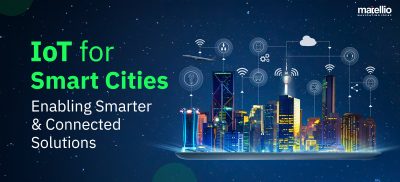
Environmental monitoring has become crucial to ensure healthy living. Enterprises are focusing on green technology by capitalizing on state-of-the-art environmental monitoring systems. IoT-based environmental monitoring systems allow supervisors and managers to monitor current/ remote sites for conditions such as rain, temperature, humidity, harmful gases, etc. These systems are a combination of wireless sensor network operations which can be adjusted based on various parameters. These are small autonomous wireless sensor nodes and receivers connected over the internet. Once they collect important data, they transmit the same to cloud-based solutions for storage and analysis.
These systems can be programmed to alert the supervisors in an abnormal environment. For instance, suppose there is a fire in a manufacturing factory. Since the fire is currently confined to a small area, the workforce hasn’t realized it yet. However, an IoT-based environment monitoring system detects the sudden spike in the room temperature and sends an alert to the managers and teams. They can check the premises and take action accordingly to limit the loss. In certain cases, these systems can also send the information to the fire department, which can come and put out the fire before it spreads beyond control.
Let’s check how they function and how businesses can maximize the value of their investment in IoT-based environmental monitoring systems.
What Makes an IoT-based Environmental Monitoring System?
Let’s discuss the components of an IoT-based environmental monitoring system.
1. Data Aggregators
Sensors or data aggregators collect real-time data from the connected systems. Data hence collected is further sent to the analyses.
2. Data Analytics System
To measure environmental impact, these systems must make it possible to evaluate key data points that can indicate everything from water and chemical leaks to critical equipment failures. Industrial operators and municipalities can use this data to measure their environmental footprint and take action to reduce waste, increase sustainability, manage valuable resources like water, and prevent environmental disasters.
3. Storage Database
Data collected is securely stored in the cloud-based systems. This data is categorized into multiple forms based on relevance and utilized for analyses.
4. Display Dashboards and Applications
Once the data is available in patterns and trends, it is displayed on the dashboards for the stakeholders. They can use these insights to make corresponding business decisions and even program the IoT applications to send alerts and notifications.
What are the Use Cases of IoT-based Environmental Monitoring System?
1. Water Quality Monitoring
Clean water is one of the prime life requirements. Today, technology is helping governments to lead healthier lives with the best quality water. IoT-powered water monitoring systems help municipal corporations, building authorities, and agricultural specialists analyze water for the presence of contaminants, oxygen levels, pH levels, and more. With the right information, they can decide about the water treatment methodologies.
Best examples of IoT-based water quality management tools include:
- Water treatment monitoring
- Groundwater monitoring
- Irrigation water monitoring
- Drinking water monitoring
2. Air Quality Monitoring
Poor air quality can lead to adverse health problems. Industries and municipalities deploy IoT-based air quality monitoring systems to prevent such conditions. These systems can identify contaminants and harmful gases in the air. They can locate greenhouse gases like CO, hydrocarbons, and chemicals. This helps municipal corporations to mitigate the impacts and industries take the right measures to avoid emissions.
Key examples of IoT-based air quality monitoring solutions include:
- CO monitoring systems
- Methane monitors
- Industrial air quality monitors
3. Energy Monitoring
Energy monitors are vital not just for industrial units but also for municipal corporations to improve the quality of urban lives. IoT-based solutions help with cutting-edge detection of energy wastage and ways to improve consumption efficiency. The method majorly relies on the energy grids.
The electric grid refers to the network of transmission lines, substations, transformers, and more than transmitting electricity from powerplants to the target locations. Smart electric grids represent the digital transformation of electricity networks. It allows a two-way flow of electricity. They can collect real-time data to detect, analyze, and proactively react to changes in usage and related issues. They also have self-healing capabilities and enable consumers to participate proactively.
How to Launch an IoT-based Environmental Monitoring System?
The right step to developing an IoT-based environmental monitoring system is to hire an IoT development company. This is because it involves hardware and software development expertise for a solution that aligns with your requirements. The right IoT development services provider will help you prepare the right roadmap to guide you to success. They start with clearly understanding the problems you are facing and how you can best address them.
You can shortlist the IoT development company based on the following parameters:
- Experience in IoT development
- Hands-on experience in IoT software development for industries
- Quality of IoT development services they offer
- Reviews and ratings from recent clients
- Overview and expertise of their IoT projects
- Additional USPs in IoT development
At Matellio, we take care of all these requirements with our experienced business technology consulting experts. Let’s talk about our process in detail.
1. Analyzing Your Business Readiness for IoT and Identify the KPIs
The initial stage is to understand your requirements and help uncover potential gaps you can fill with IoT development services. You also need to ensure that you have listed all the KPIs against which you will analyze the progress of IoT development in your organization.
Our business technology consultants will help you achieve this target while creating the right roadmap. For instance, just developing a data analytics system is not enough. You also need a reliable system that securely collects this data and helps manage it. As IoT relies on this data, your business needs to answer the following questions:
a. What data management tools are you using for IoT app development?
IoT app development comes with a lot of data and only grows with time. Your team needs to ensure that this data is securely saved. Any data breach may damage your business reputation and cause the loss of very important business data.
b. Is your security infrastructure up for the challenge?
The higher number of devices means higher entry points for cyber security threats. This risks your data, requiring a strong security backup in encryption, blockchain, frameworks, etc.
c. How to integrate IoT solutions with legacy systems?
As an IoT development company, we follow standardized processes and industry guidelines. We understand the IoT system should be extensible to the existing ERP solutions.
Matellio’s IoT consultation experts can help you here. Our experience delivering IoT solutions for global organizations gives us the right technology insight and understanding. Our expertise can help you create the right IoT implementation strategy and maximize your returns from the investment.
2 IoT Software Development
Matellio follows an agile methodology for custom IoT development. These are the stages that we generally go through.
Step 1: Discovery of all the IoT development requirements for your bank
Step 2: SRS creation with scope freezing
Step 3: UI/ UX development
Step 4: Hardware/ software development
Step 5: QA testing services
Step 6: Bug fixes
Step 7: Deployment
Also Read- IoT Software Development: A Complete Guide
Are You Looking for IoT-based Environmental Monitoring System Development?
IoT-based environmental monitoring systems are the need of the hour for industrial units trying to make an impact. It helps them stay ahead of the competitive curve by creating an ecosystem that is safer and profitable at the same time. If you are someone looking to lead a revolution with an innovative IoT development company by your side, Matellio can help. Let’s talk more on a FREE consultation call with our experts. Book now!






